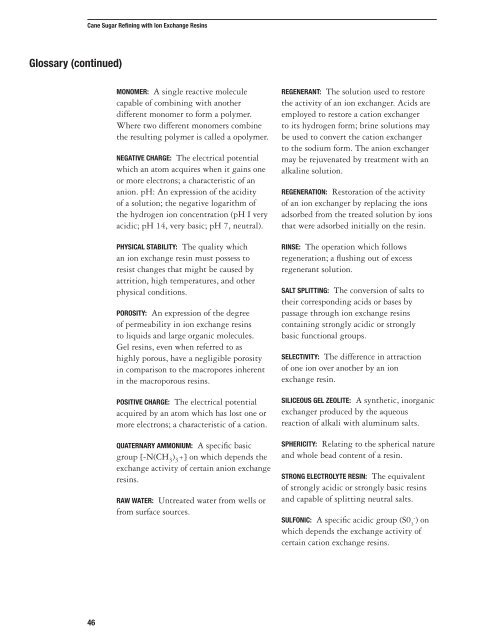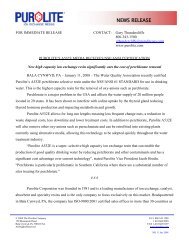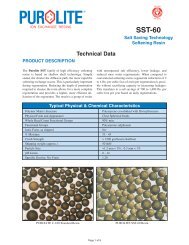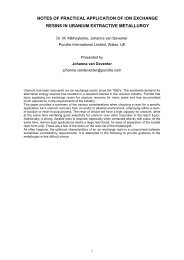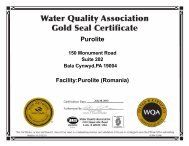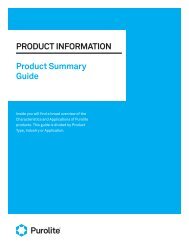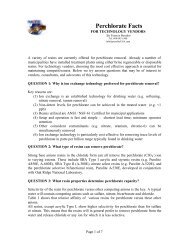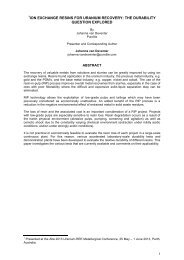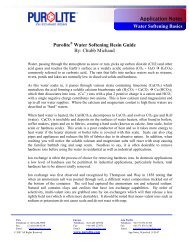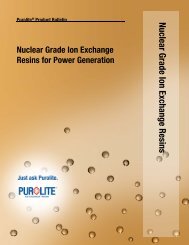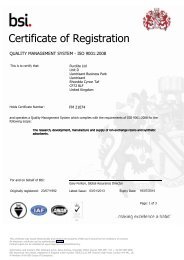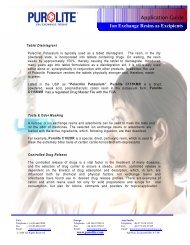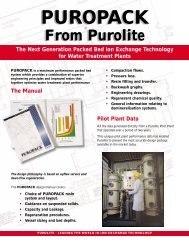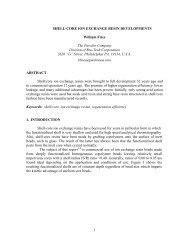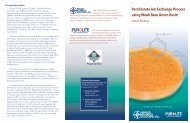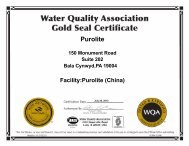Cane Sugar Refining - Purolite
Cane Sugar Refining - Purolite
Cane Sugar Refining - Purolite
You also want an ePaper? Increase the reach of your titles
YUMPU automatically turns print PDFs into web optimized ePapers that Google loves.
Glossary (continued)<br />
<strong>Cane</strong> <strong>Sugar</strong> <strong>Refining</strong> with Ion Exchange Resins<br />
46<br />
MONOMER: A single reactive molecule<br />
capable of combining with another<br />
different monomer to form a polymer.<br />
Where two different monomers combine<br />
the resulting polymer is called a opolymer.<br />
NEGATIVE CHARGE: The electrical potential<br />
which an atom acquires when it gains one<br />
or more electrons; a characteristic of an<br />
anion. pH: An expression of the acidity<br />
of a solution; the negative logarithm of<br />
the hydrogen ion concentration (pH I very<br />
acidic; pH 14, very basic; pH 7, neutral).<br />
PHYSICAL STABILITY: The quality which<br />
an ion exchange resin must possess to<br />
resist changes that might be caused by<br />
attrition, high temperatures, and other<br />
physical conditions.<br />
POROSITY: An expression of the degree<br />
of permeability in ion exchange resins<br />
to liquids and large organic molecules.<br />
Gel resins, even when referred to as<br />
highly porous, have a negligible porosity<br />
in comparison to the macropores inherent<br />
in the macroporous resins.<br />
POSITIVE CHARGE: The electrical potential<br />
acquired by an atom which has lost one or<br />
more electrons; a characteristic of a cation.<br />
QUATERNARY AMMONIUM: A specific basic<br />
group [-N(CH 3 ) 3 +] on which depends the<br />
exchange activity of certain anion exchange<br />
resins.<br />
RAW WATER: Untreated water from wells or<br />
from surface sources.<br />
REGENERANT: The solution used to restore<br />
the activity of an ion exchanger. Acids are<br />
employed to restore a cation exchanger<br />
to its hydrogen form; brine solutions may<br />
be used to convert the cation exchanger<br />
to the sodium form. The anion exchanger<br />
may be rejuvenated by treatment with an<br />
alkaline solution.<br />
REGENERATION: Restoration of the activity<br />
of an ion exchanger by replacing the ions<br />
adsorbed from the treated solution by ions<br />
that were adsorbed initially on the resin.<br />
RINSE: The operation which follows<br />
regeneration; a flushing out of excess<br />
regenerant solution.<br />
SALT SPLITTING: The conversion of salts to<br />
their corresponding acids or bases by<br />
passage through ion exchange resins<br />
containing strongly acidic or strongly<br />
basic functional groups.<br />
SELECTIVITY: The difference in attraction<br />
of one ion over another by an ion<br />
exchange resin.<br />
SILICEOUS GEL ZEOLITE: A synthetic, inorganic<br />
exchanger produced by the aqueous<br />
reaction of alkali with aluminum salts.<br />
SPHERICITY: Relating to the spherical nature<br />
and whole bead content of a resin.<br />
STRONG ELECTROLYTE RESIN: The equivalent<br />
of strongly acidic or strongly basic resins<br />
and capable of splitting neutral salts.<br />
-<br />
SULFONIC: A specific acidic group (S0 ) on 3<br />
which depends the exchange activity of<br />
certain cation exchange resins.


